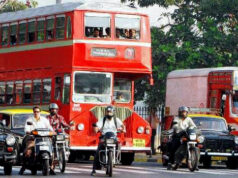By: Surbhi Tandon (Intern, CCS) and Vipin P. Veetil (Research Guide, CCS)
“The monetary stance remains firmly anti-inflationary…” said D Subharao – Governor of the Reserve Bank of India – on Thursday 16 June. If the very institution with a monopoly over production of money in India is fighting inflation, then who is causing it?
Money is a tricky good. Like other commodities it too dances to the tunes of demand and supply, yet like Escher’s Waterfall it lives a deceitful circularity. Imagine a bumper harvest of rice, what happens to the price rice? Simple, it falls. Money is no different, the greater the supply of money relative to demand, lower the price of money, in other words higher the price of all other goods in terms of money aka inflation.
Economists have different measures of money, ranging from M0 which essentially means ‘notes and coins in circulation’ to M3 which includes ‘term deposits in banks’. Some measures of money are endogenous to an economy, i.e. proceeding from within the economy. More intense economic activity may lead to increases in savings deposits and term deposits, thereby increasing broad measures of money like M2 and M3. But M0 is an altogether different animal; the RBI has a legal monopoly for minting money, i.e. it is largely exogenous to an economy. We decided to snoop in on some RBI data on ‘notes and coins’. And here is what the data had to say.
Table 1: Notes and Coins in Circulation
| Year | ‘Notes and Coins’ in Circulation | Index |
| 1951-52 | 12,920,000,000 | 100 |
| 1970-71 | 45,570, 000,000 | 353 |
| 2000-01 | 2,182,050,000,000 | 16,900 |
| 2010-11 | 9,495,210,000,000 | 73,500 |
In the financial year 2010-11 there was 735 times as many notes and coins in circulation as in 1951-52, thanks to RBI’s printing press. So why do we have inflation? Simple, the growth in ‘notes and coins in circulation’ has far outstripped the growth in real goods and service. And M0 is as exogenous as exogenous gets; RBI is the sole producer of money. RBI’s own numbers fly in the face of Subharao and his predecessors claim that ‘the bank is fighting inflation’.
But there is more to money that just this. It’s got a deceitful circularity. The Reserve Bank doesn’t sprinkle new notes and coins from a helicopter. It lends newly produced money to banks and government. Typically big banks, large business houses and government tend to benefit from new currency as they borrow and demand real resources. This pushes up prices a little. A second round begins when private firms down the supply chain and sub-contractors of government get new contracts, they in turn demand real resources, and prices go up a little. This process continues little prices rise commensurate to the initial injection of new currency. The great deceit lies in the fact that the first group (banks, government, and business houses) demands real resources at original prices, the second group at slightly higher prices, and the full brunt of inflation is borne by the ‘common masses’ who demand goods in the last round.
Do we have an alternative? B. Chandrasekaran tells us – in a recent Pragati article – that B R Ambedkar was very concerned about the question of currency. Quoting Ambedkar: “Besides, a managed currency is to be altogether avoided when the management is to be in the hands of the Government. When the management is by a bank there is less chance of mismanagement. For the penalty for imprudent issue, or mismanagement is visited by disaster directly upon the property of the issuer.
But the chance of mismanagement is greater when it is issued by Government because the issue of government money is authorised and conducted by men who are never under any present responsibility for private loss in case of bad judgement or mismanagement”
One possible solution is a system of private money perhaps. Recommended reading: Hayek’s Denationalization of Money. Another solution is the Friedman Rule: let the rate of growth of money supply match the rate of growth of real goods and services. Enjoy this thought provoking video: Friedman on Inflation
On a lighter note, we asked CCS interns ‘What is the first thing that comes to your mind when you hear the word ‘inflation’? Here is what they had to say.
Udita (Lady Sri Ram College): “Whenever I see the inflation figures I get worried about it having a direct effect on the monthly allowance I get. Also I feel the need to be financially independent asap. I think about more negotiation that I would have to do with the autowallahs everyday as the inflation goes up”
Snighdha (Ramjas College): “I become apprehensive of the fact that commodities like clothes and shoes would expensive. Also my great concern is cinema tickets prices shooting up each time with inflation figures”
Pradnya (National Law University, Jodhpur): “ I am indifferent to inflation rates. My only concern is rising price of boil of rice at her mess. I have seen prices grow from Rs.9 to Rs.20 nowadays”.
Jasraj (Sri Venkateswara College, University of Delhi): “For me inflation is about how worthless money actually is. In 1940 with one rupees we could buy 16 kilograms of ghee and you can’t even buy a decent toffee with one rupee in 2011”
Neil (University of Birmingham): “as soon I see inflation figures I visualize Sushma Swaraj speaking against inflation”Safal (Amity University): “As I see inflation figures I realize that India is still a poor country. Also I am worried about petrol price rise every week. Plus, maybe cameras will become more expensive in near future”
Subhaprad: “Inflation is a dangerous word, its’ the worst thing for middle class families. I believe that government is not serious on inflation and only cares about the growth and food grains are becoming very expensive these days. They only look for solutions during election time”
Akansha (Lady Sri Ram College): “Corruption is not associated with inflation. I think inflation levels have a direct impact on income expectation from the people you employ”
Shashank (National Institute of Technology, Hamirpur): “the value of money in my pocket is going to reduce” Anubhuti (Department of History, University of Delhi): “When I see inflation figures I believe that this congress government is going to loose next elections. Its’ all related to corruption. Anna hazare comes to my mind”
David (St. Stephen’s College) : “It used to take ten bucks from Stephens’ College to Kamala Nagar in a cycle rickshaw earlier. But now the rickshaw wallah asks for twenty bucks”.
Aditi (Indian Institute of Technology, Chennai) : “Nobody has explained completely or has reached a consensus on what is the root cause of inflation. Neither they have come up with a consensus on best metric to measure inflation. Though I love Antonio Gramsci”.
And that’s how the cookie crumbles.
Post Disclaimer
The opinions expressed in this essay are those of the authors. They do not purport to reflect the opinions or views of CCS.





